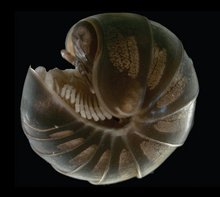Glomerida
| Glomerida | |
|---|---|
 |
|
| Glomeris sublimbata | |
| Scientific classification | |
| Kingdom: | Animalia |
| Phylum: | Arthropoda |
| Subphylum: | Myriapoda |
| Class: | Diplopoda |
| Subclass: | Chilognatha |
| Infraclass: | Pentazonia |
| Superorder: | Oniscomorpha |
| Order: |
Glomerida Brandt, 1833 |
| Families | |
|
Glomeridae |
|
| Synonyms | |
|
Plesiocerata Verhoeff, 1910 |
|
Glomeridae
Glomeridellidae
Trachysphaeridae (=Doderiidae)
Plesiocerata Verhoeff, 1910
Glomerida is an order of pill-millipedes found primarily in the Northern Hemisphere. They superficially resemble pill-bugs or woodlice, and can enroll into a protective ball. They have twelve body segments, 17 to 19 pairs of legs, and males have enlarged rear legs involved in mating. The order includes about 30 genera and at least 280 species, including Glomeris marginata, the common European pill-millipede. The order contains members in Europe, South-east Asia and the Americas from California to Guatemala. Although historically considered closely related with the similar sphaerotheriidans that also enroll, some DNA evidence suggest they may be more closely related to glomeridesmidans, a poorly known order that does not enroll.
Glomeridans are small, oval-shaped millipedes reaching up to 20 mm (0.79 in) long. Like the Sphaerotheriida (so-called Giant Pill-millipedes), they are capable of enrolling into a ball ("volvation"), a trait also shared with the unrelated pillbugs (Oniscidean crustaceans). They possess 12 body segments, although the second and third dorsal plates (tergites) may be fused, and the 11th tergite may be small or partially hidden to appear as 11 segments. The last tergite is enlarged and shield like. The head is relatively large and round, possessing long, slender antennae, and horseshoe-shaped Tömösváry organs. Eyes may be present or absent. The collum (first segment behind the head) is small while the second tergite is greatly enlarged. Defensive glands (ozopores) are situated dorsally, in contrast to the lateral ozopores of most other millipedes. Males and females differ in the number of leg pairs: males have 17 while females have 19. Additionally, in mature males the last leg pair is modified into clasping appendages known as telopods.
...
Wikipedia
